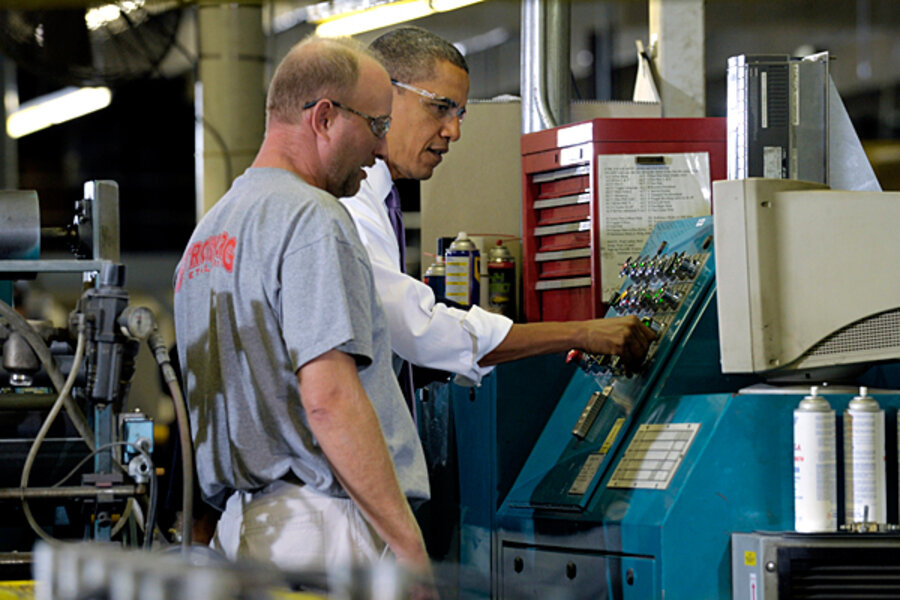Consumers, businesses boost US economy; 5 things we learn from GDP report
Loading...
| New York
Consumers and businesses gave the US economy a lift this summer, but it appears their taste for imports limited the benefit from their increased spending.
In the government’s initial look at the economy’s performance between July and September, the US Commerce Department reported Friday that the Gross Domestic Product eked out an annual growth rate of 2 percent, up from 1.7 percent in the second quarter.
Most of the growth came from consumer spending, companies adding to their inventories, business investment, and some left-over fiscal stimulus spending.
However, US consumers and businesses also purchased a lot of goods from overseas. Those imports lowered the Commerce Department’s calculated growth rate by 2 full percentage points.
“The imports were the difference between strong growth and lackluster growth,” says Joel Naroff of Naroff Economic Advisors in Holland, Pa.
Although the GDP report is a look through a rearview mirror, it also gives some views of what is happening to the US economy. Here are five things economists say can be learned from the report:
Consumers
Consumers are doing their part to stimulate the economy. Over the summer consumer spending, spurred by purchases of small items, rose by a 2.6 percent annual pace, the best performance for the consumer since 2006.
“They are buying smaller things, personal goods, nondurables, using more services such as taking their clothes to the dry cleaners,” says Mr. Naroff.
Businesses
Businesses are buying computers, software and other high-tech goods. This boosted the economy by 0.8 percentage points. Business spending on such goods rose by 12 percent for the quarter, the fourth consecutive quarter of double digit gains.
“They are finding the dollars and they are spending them,” says Naroff. “This tells me businesses are a little more confident.”
Inventories
Companies decided to rebuild their inventories. This added 1.44 percentage points to the economy, notes Fred Dickson, chief investment strategist at D.A. Davidson & Co. in Lake Oswego, Oregon.
“This is not surprising, business typically builds inventory in anticipation of holiday sales,” says Mr. Dickson. “I think the seasonal aspect explains some of it.”
Economists don’t expect the inventory accumulation to continue. “During the October-December quarter, inventories could be a significant drag on economic growth,” writes economist Sung Won Sohn of California State University, Channel Islands, in an analysis.
Interest Rates
The GDP report is unlikely to change anyone’s mind at the Federal Reserve about whether to begin a new program of lowering longterm interest rates. On Wednesday, the Fed is expected to announce it will start to buy longterm US Treasury debt as part of the program, called quantitative easing. That effort is controversial within the Fed with some governors warning about potential inflationary consequences and others concerned about deflation or the lowering of prices if nothing is done.
“The GDP report confirms to those who believe in it that quantitative easing is needed,” says Mr. Naroff. “Whether it will have an impact is a different story.”
Economists at Wells Fargo & Co. anticipate the Fed will buy about $500 billion in securities over the next six months. “While some calculations consider up to $2 trillion of purchases, there is likely not enough consensus at the Fed for a shock-and-awe approach,” writes the bank in an analysis on Friday.
Political impact
The GDP report may also have some political ramifications. The GDP is the last significant economic report before the mid-term elections and quickly generated comment from both sides. At the White House, Austan Goolsbee, chair of the Council of Economic Advisers, highlighted that the report is the fifth straight quarter of positive economic growth. But, he added, “Given the depth and severity of the recession, considerable work remains before our economy is fully recovered.”
However, House Republican leader John Boehner blamed the slow economy on President Obama’s policies and reiterated his call to extend the Bush tax hikes for all Americans, not just the middle class.
“Either side can use the results,” says Scott Brown, chief economist at Raymond James & Associates in St. Petersburg, Fla. “The GDP is more of a good news, bad news story – the good news is the economy grew, the bad news is that it was not strong enough.”





